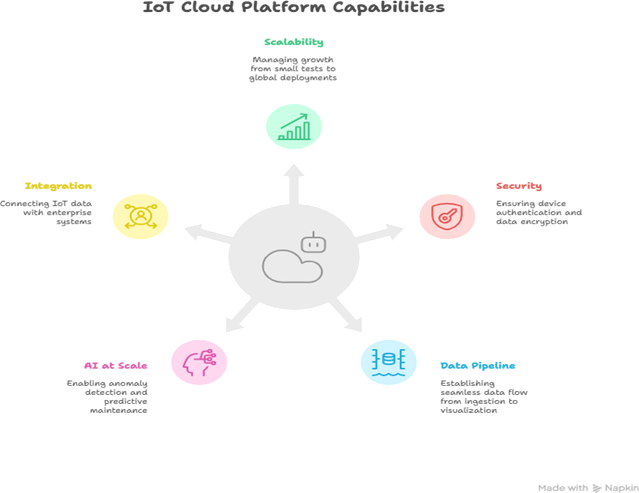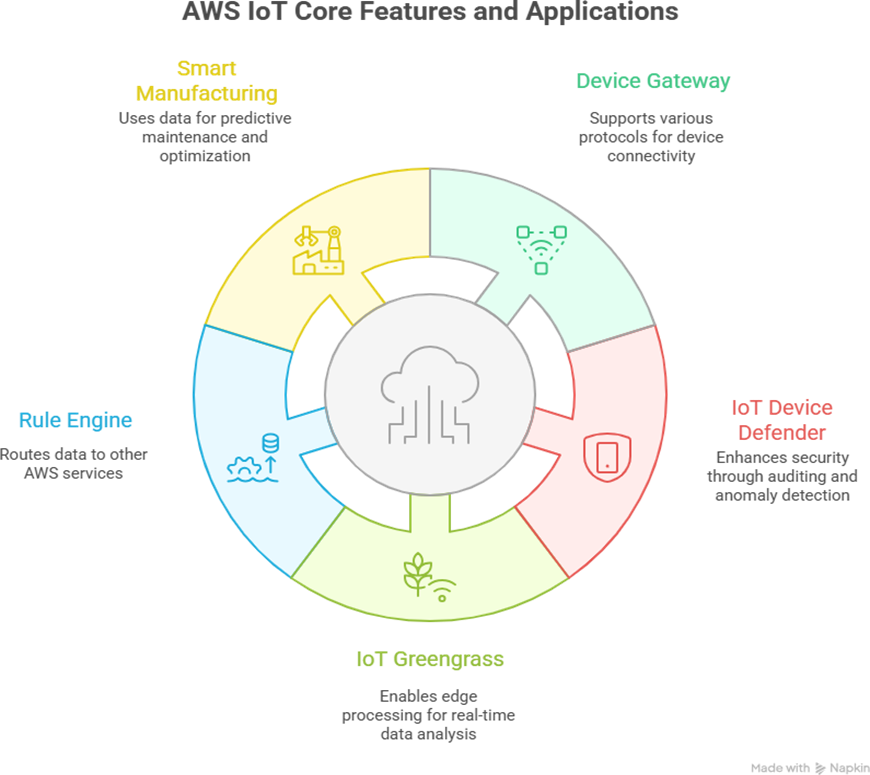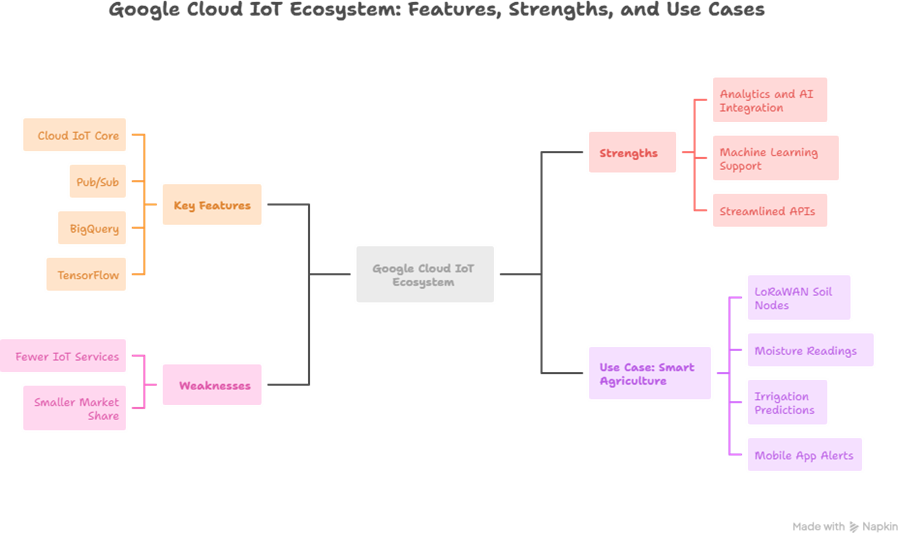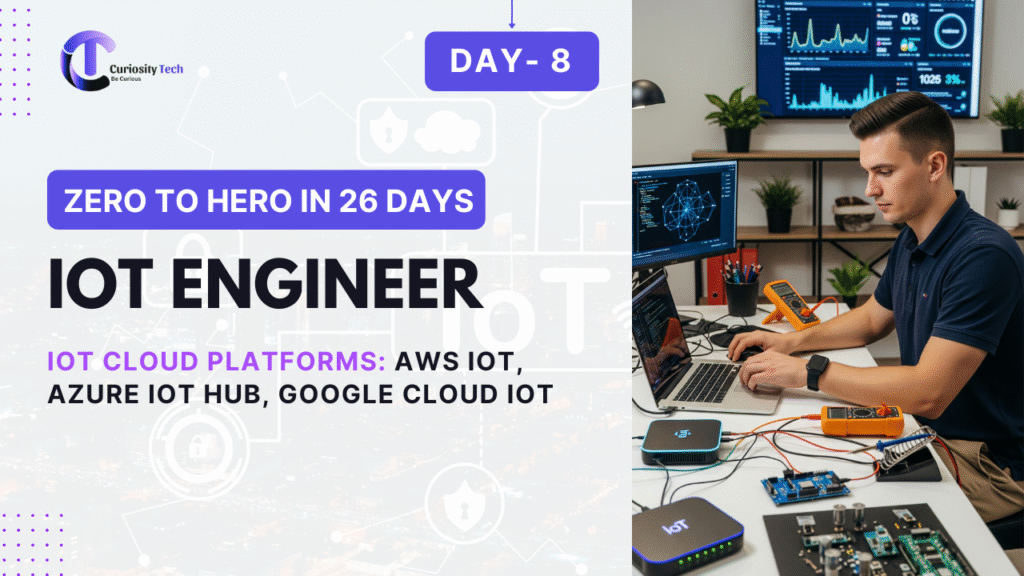Introduction
When IoT devices send millions of data points every second, where does all that data go? The answer is: IoT Cloud Platforms. These platforms act as the nervous system for global IoT – collecting telemetry data, securing device communication, enabling analytics, and applying AI for actionable insights.
The three global leaders in this space — Amazon Web Services (AWS IoT), Microsoft Azure IoT Hub, and Google Cloud IoT Core — dominate enterprise-scale deployments. Together, they power smart factories, agriculture grids, healthcare monitoring, and consumer IoT ecosystems.
Think of this blog as your Cloud IoT Platforms Playbook for 2025.
Why IoT Cloud Platforms Matter

At CuriosityTech.in Nagpur, we emphasize that IoT isn’t just “device + app.” Without a robust cloud backend, projects collapse after pilot phases.
Platform 1: AWS IoT Core (Amazon Web Services)

Use Case:
Smart Manufacturing — Machines across multiple plants continuously publish vibration metrics to AWS IoT, which then routes the data through Kinesis Streams into SageMaker AI models for predictive maintenance.
Platform 2: Microsoft Azure IoT Hub
- Overview: Azure’s specialized service for remote monitoring and device management.
- Key Features:
- Bi-directional device-to-cloud and cloud-to-device communication.
- IoT Edge — run containerized code directly on edge devices.
- Digital Twins — virtual models of real-world systems.
- Tight integration with enterprise Microsoft services (Office, Dynamics, Power BI).
- Strengths:
- Excellent developer productivity tools.
- Powerful business intelligence & analytics (via Power BI).
- Edge computing support with AI/ML integration.
- Weaknesses:
- Less flexibility compared to AWS in multi-service orchestration.
- Works best in Microsoft-based enterprises.
Use Case:
Healthcare IoT — Wearable patient monitors send data to Azure IoT Hub. Doctors view Power BI dashboards, while Azure Machine Learning triggers early disease alerts.
Platform 3: Google Cloud IoT (Google Cloud IoT Core + Data Suite)

Use Case:
Smart Agriculture — LoRaWAN-based soil nodes send moisture readings to Google IoT Core → forwarded to BigQuery → ML models predict irrigation needs → mobile app alerts farmers.
This is often prototyped at CuriosityTech hackathons in Nagpur, where agricultural startups test how cloud predictions can automate irrigation.
Comparative Reference Chart
| Feature | AWS IoT Core | Azure IoT Hub | Google IoT Core |
| Communication Protocols | MQTT, HTTPS, LoRaWAN | MQTT, HTTPS, AMQP | MQTT, HTTPS |
| Edge Processing | IoT Greengrass | Azure IoT Edge | Google Edge TPU, AI APIs |
| Security | Device Defender, IAM | Azure Security Center | Cloud IAM, device certs |
| Analytics & ML | SageMaker, Kinesis | Power BI, ML Studio | BigQuery, TensorFlow |
| Ease of Use | Moderate (complex) | High (Microsoft integration) | Moderate (simple APIs) |
| Best Fit | Large enterprises | Enterprises with MS stack | AI/Analytics-centric apps |
Conceptual Cloud Architecture Diagram (Described)
- Device Layer: Sensors & IoT MCUs publish via MQTT/HTTP.
- Gateway Layer: Edge nodes preprocess and send upward.
- Cloud Ingestion Layer: Platform (AWS, Azure, Google IoT Core).
- Processing Layer: Rules engine → streaming data → AI/ML integration.
- Application Layer: Dashboards, mobile apps, industrial consoles.
This diagram is commonly drawn during CuriosityTech IoT cloud labs, showing students how sensor data travels “from soil to cloud to human-eye dashboard.”
Common Beginner Errors
- Choosing AWS for small-scale prototypes → cost escalations.
- Using HTTP upload loops instead of lightweight MQTT → drains battery.
- Ignoring security certificates → default connections vulnerable.
- Overestimating Google Cloud IoT’s IoT-native features — needs external service coupling for maturity.
Expert Roadmap: Learning Cloud Platforms
- Begin with managed IoT dashboards (like ThingsBoard or Ubidots).
- Experiment with AWS IoT Core free-tier — explore MQTT message routing.
- Move to Azure IoT Hub — understand device twins and bi-directional control.
- Test AI/ML within Google Cloud IoT for sensor data analysis.
- Deploy hybrid systems (e.g., Azure for enterprise compliance + AWS for scalability).
At CuriosityTech in Nagpur, students often learn via Incremental Projects:
- First week → Farming sensor with AWS IoT Core.
- Second week → Healthcare wearable prototype with Azure IoT Hub.
- Third week → Predictive irrigation model on Google Cloud IoT + TensorFlow.
Conclusion
The backbone of global IoT isn’t in the sensor hardware or even the network protocols — it lies in cloud platforms that aggregate, secure, and make data meaningful. AWS leads in ecosystem, Azure leads in enterprise integration, Google leads in AI. The true IoT engineer of 2025 isn’t tied to one, but knows how to choose based on project needs.
That’s why ecosystems like CuriosityTech.in Nagpur expose learners to all three platforms in real IoT project simulations, ensuring engineers graduate with cloud selection wisdom, not just cloud usage skills.

